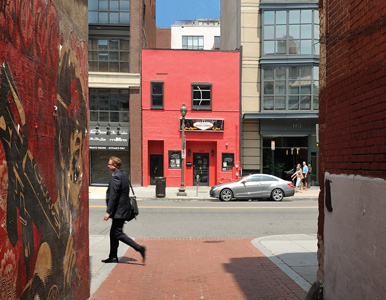
The names of the streets are virtually the only things that haven't changed. From the aftermath of the riots in the late 1960s until the dawn of the new millennium, Washington's Shaw-U Street neighborhood was emblematic of urban blight and decay. Then odd things started happening. Go-go clubs shuttered their doors, while coffee shops selling $5 lattes began moving in. African American churches closed; beer gardens opened. Housing prices skyrocketed. Parks where drug dealers once slung have been cleaned up and refashioned into gathering spots for people and their leash-less, frolicking labradoodles.
It's a process called "gentrification," which refers to the transformation an urban area undergoes when longtime lower-income residents are replaced by a flood of affluent newcomers. It's a multifaceted (and often combustible) subject that Derek Hyra, School of Public Affairs professor, studies at AU's Metropolitan Policy Center.
In his 2017 book, Race, Class, and Politics in the Cappuccino City, Hyra examines the consequences—both intended and unintended—of gentrification in what was one of "Chocolate City's" most vibrant African American neighborhoods in the mid-twentieth century.
"Between 2000 and 2010, you had a 5.2 percent population increase in the city," says Hyra, who founded the center in 2014. "The majority of that population was young and white. They couldn't afford downtown, so where did they look? U Street, Seventh Street, Fourteenth Street—historic black neighborhoods that have changed significantly."
In the United States, gentrification traditionally has negatively impacted people of color, but the term was coined by British sociologist Ruth Glass in 1964 to describe class changes—not racial ones—in parts of London. Hyra is particularly interested in how gentrification affects the social construct of neighborhoods. While crime rates can go down, dramatic increases in housing costs and property taxes drive out many poorer residents. But even those with subsidized housing who can afford to stay often feel disillusioned due to the political and social changes in their neighborhood.
Parts of the U Street corridor "look incredibly diverse in terms of race, ethnicity, sexual orientation, and age," Hyra says. "But when you start to delve into civil society, it segregates. The churches, the restaurants, the recreation centers, the parks. The potential benefit for low-income people was based on a set of social interactions that would happen, and we're not seeing as many social interactions because of this microsegregation."
Hyra's latest project is a historical analysis of the conditions that existed in American cities where riots erupted in 1968—following the assassination of Martin Luther King Jr.—and those today in cities like Baltimore, Charlotte, and Ferguson, where violence broke out in the streets following alleged police brutality.
"We want to look at income equality, public housing, and other factors to see how that might have led to the social unrest we've seen since 2010," he says.
Much of Hyra's work has a common theme.
"How do you bring resources to disadvantaged environments so you can have a more equal playing field that allows people to reach their life goals?" he says. "It's about trying to better communities."